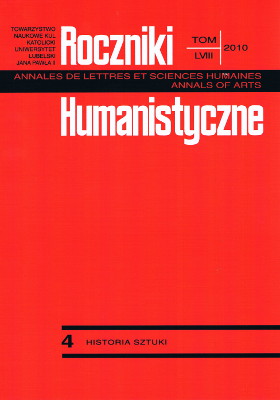In the Dark. History of Art and the Art of Touch
Abstract
A dark room is a “research field” where an art historian moves with uncertainty. The strongest sensual experience that an art historian develops when his/her competence grows is seeing. The most valued trait of an art expert - a collector, museum specialist or an exhibition manager - is his/her “sharp eye”. The methodological paradigm that has dominated in art. history since the 1970s established the accepted “ways of seeing” art. The choice of touch for the subject matter of this paper is not meant as a challenge to the established hierarchy of senses underlying the above-mentioned research paradigm. The eye will stay in the centre of our research, even though not all art is created to be experienced through this sense only. This paper ventures an interpretative analysis of a selection of works which are not to be experienced solely through sight, but mostly by touch. Mirosław Bałka's installation entitled How It Is (2009-2010), exhibited in the London Tate Modern, Anthony McCalls works in his exhibition at the Serpentine Gallery (2007-2008), or Filippo Tommaso Marinetti's project called “the art of tactilism”, reaching back to the 1920s – these are examples of creations which make art. history grope around in the dark. The author does not aim to juxtapose sight and touch in art. interpretation, or to seek some "new empiricist" methodology. The paper is more of an attempt to criticise research tradition that favours sight over touch. Immediacy and elimination of distance are features that distinguish tactile experience from the visual one. In view of the fact that contemporary artistic practices strive to integrate and consolidate all sensual experiences in a holistic fashion, one can pose a crucial question of how to grasp and record the immediate tactile experience in the process of art-historical interpretation.
References
Augé M., Non-Places: Introduction to an Anthropology of Supermodernity, tłum. J. Howe, London: Verso 1995.
McCall A., „Line Describing a Cone” and Related Films, „October” 2003, vol.103.
Connor S., The Book of Skin, Ithaka−New York: Cornell University Press 2004.
Deleuze G., Guattari F., A Thousand Plateaus: Capitalism and Schizophrenia, tłum. B. Massumi, Minneapolis−London: University of Minnesota Press 2005.
Edwards E., Raw Histories: Photographs, Anthropology and Museums, Oxford: Berg 2001.
Diderot D., List o ślepcach dla użytku tych, co widzą (1749), [w:] tenże, Wybór pism filozoficznych, tłum. J. Hartwig i J. Rogoziński, DeAgostini, Warszawa: Altaya 2003.
Fiennes C., The Journeys of Celia Fiennes, London: The Cresset Press 1949.
Gołaszewska M., Estetyka pięciu zmysłów, Warszawa−Kraków: PWN 1997.
Herkenhoff P., The Illuminating Darkness of How It Is, [w:] Miroslaw Balka. How It Is, red. H. Sainsbury, katalog wystawy w Tate Modern (13.10.2009-5.04.2010), London: Tate Publishing 2009, s. 50-102.
Juszkiewicz P., Linia ratunkowa. Od jasnowidztwa do ślepoty, [w:] Awangarda w bloku, red. G. Świtek, Warszawa: Fundacja Galerii Foksal 2009.
Kirby M., Marinetti's Short Plays, „The Drama Review” 1973, vol. 17, nr 4.
Locke J., An Essay Concerning Human Understanding, red. P. H. Nidditch, Oxford: Clarendon Press 1979.
Marinetti F. T., Tactilism (1924), [w:] Marinetti: Selected Writings, red. R.W. Flint, tłum. R. W. Flint, A. A. Coppotelli, London: Secker & Warburg 1972.
Marinetti F. T., The Tactile Quartet, tłum. V. N. Kirby, „The Drama Review” 1973, vol. 17, nr 4, s. 122-123.
Marks L. U., Touch: Sensuous Theory and Multisensory Media, Minneapolis MN: University of Minnesota Press 2002.
Martinich A. P., Hobbes: A Biography, Cambridge: Cambridge University Press 1999.
Merleau-Ponty M., Fenomenologia percepcji, tłum. M. Kowalska, J. Migasiński, Warszawa: Aletheia 2001.
Piwocki K., Pierwsza nowoczesna teoria sztuki. Poglądy Aloisa Riegla, Warszawa: PWN 1970.
Poprzęcka M., Inne obrazy. Oko, widzenie, sztuka. Od Albertiego do Duchampa, Gdańsk: słowo/obraz terytoria 2008.
Saito Y., Everyday Aesthetics, Oxford: Oxford University Press 2010.
Sennett R., The Craftsman, London: Penguin Book 2009.
Sensible Flesh: On Touch in Early Modern Culture, red. E. D. Harvey, PhiladelphiaPA: University of Pennsylvania Press 2002.
Tallis R., The Hand: A Philosophical Inquiry into Human Being, Edinburgh: Edinburgh University Press 2003.
The Book of Touch, red. C. Classen, Oxford−New York: Berg 2005.
Tuck R., Introduction, [w:] T. Hobbes, Leviathan, red. R. Tuck, Cambridge: Cambridge University Press 2002.
Walley J., An Interview with Anthony McCall (February/November 2004), [w:] A. McCall, The Solid Light Films and Related Works, red. C. Eamon, Göttingen: Steidl & Partners 2005.
Copyright (c) 2010 Roczniki Humanistyczne

This work is licensed under a Creative Commons Attribution-NonCommercial-NoDerivatives 4.0 International License.





